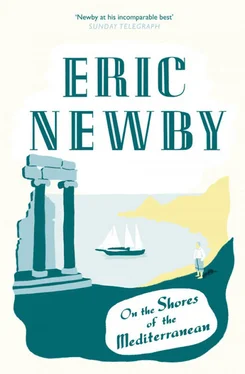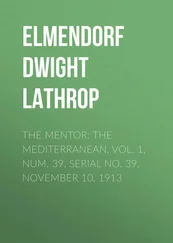Now the season was nearly over. Soon the Highway would be largely deserted, except by long-distance lorries, and the cleaning-up squads would emerge to haul away the wrecks of automobiles, clear away the beer cans, burn the plastic, unblock the drains in the camp sites and replace the shattered lavatories and wash basins. We kept our spirits up by reminding one another that we were on our way to Cetinje in Montenegro where we were going to stay in the Grand Hotel.
The road to Cetinje, the former capital of Montenegro, begins near Kotor, a seaport at the head of the Gulf of the same name, an astonishing inlet of the Adriatic, with the Crna Gora, the Black Mountain from which the country takes its name, rising above it.
The town stands at the foot of the Lovčen, a summit which rises more than 5700 feet above it, and appears to be still intact behind the fortifications built by the Venetians which zigzag up the mountainside from it.
It was only necessary to go into it through the main gate down by the harbour, as we did, to realize that something was seriously wrong with Kotor. Inside the walls, the city was moribund. A great earthquake which had convulsed large portions of the Balkan Peninsula in 1979, had rendered it uninhabitable, doing to Kotor what a succession of invading Saracens, Serbians, Tartars, Hungarians, Bosnians, Venetians, Austrians, French, British, Russians, Austrians again, Montenegrins, Turks (who had unsuccessfully besieged it in 1538 and 1667), other earthquakes, in 1563 and 1667, and an outbreak of plague in 1572, had all failed to do, except temporarily.
Yet in spite of this latest misfortune Kotor, although more than half-dead, was not completely so. A few stubborn inhabitants still lived within its walls, either in deep, dark, labyrinthine streets, from most of which the afternoon sun had long since gone by the time we arrived in them, that is if it ever shone into them at all, or in little squares, some of them still sunlit, in which children played happily, streets and squares in which the houses and palaces, most of them long since converted into tenements, were often either shored up with balks of timber or else had already been gutted and were shells empty of everything except rubble. Its fate, or only hope, perhaps, depending on how one regarded such things, was to become a museum city, although even that seemed improbable, for it gave the impression that even one minor tremor might be enough to demolish it completely. Meanwhile, the bulk of its former inhabitants, hoiked into the twentieth century in this unpleasant fashion, now either lived in caravans or in lightly built, more unattractive but less dangerous modern houses out beyond the walls.
Because of all this it was no longer possible to visit what other travellers describe as the amazing treasury of the twelfth-century cathedral of St Tryphon and see the head of the city’s patron saint, also the patron saint of gardeners, who was born in Phrygia, the son of a gooseherd, and was put to death in Nicaea in about AD 250, a relic which the citizens of Kotor are said to have acquired out of a ship bound for Europe from Asia Minor, together with other assorted relics of other saints, arms, legs, etc., for 300 gold pieces. Nor was it possible to see the great wooden crucifix, with its tormented Christ nailed to it, said to have been given by Baldwin II, the last Latin Emperor of Constantinople, to the widow of a thirteenth-century Serbian king. Perennially hard-up, he also, at about the same time, disposed of the Crown of Thorns, a portion of the True Cross, the baby linen of Jesus, the Lance, the Sponge and the Chain of the Passion, the Rod of Moses and part of the skull of St John the Baptist – to St Louis, Louis IX of France, the most Christian king.
By the time we left Kotor the sun had already gone from the town completely, as it does quite early, leaving it in cold, dark shadow, and dense black clouds hung threateningly over the tops of the surrounding mountains, although, out beyond the inlet on which the city itself is built, the Gulf was still bathed in sunlight.
The main road to Cetinje by way of the Lovčen Pass was a wild one even by Montenegrin standards. It climbed the steep side of the Lovčen, on the summit of which the remains of Petar II Petrović Njegoš, Prince-Bishop of Montenegro, last of a line of prince-bishops who began to reign in 1516 when the previous ruler retired to Venice, are entombed in a remarkable mausoleum designed by the Serbo-Croat sculptor Ivan Mestrović, who died in 1962.
The road to the Pass, lined with ruined forts, climbed through plantations of oak and pine ravaged by fires that had only recently swept the mountainside. It was loosely metalled, full of pot-holes, had twenty-four major hairpin bends on it and was only one vehicle wide, with lay-bys. Its outside edge frequently overhung precipices and at some places gaps in the masonry, as they did in so many places on the Adriatic Highway, showed where vehicles had been driven clean through the protecting walls taking the occupants on what had been, presumably, a spectacular exit to eternity.
Our ascent of it was made more difficult by a large caravan of picturesquely-clad gypsies who were descending it from the Pass in horse-drawn carts, on foot and with numbers of animals running loose along with them; but finally, having emerged from a tunnel that had been driven through one of the outlying spurs of the massif, we reached the Pass, which was literally white with sheep. Here the sky was threatening and a few drops of icy rain fell. Already old women in long, rusty black skirts and white-moustached men wearing little round black pill-box hats and waistcoats and what looked like baggy jodhpur breeches of heavy, brown homespun were urging the flocks and the cattle that had been grazing around the head of the Pass down to the little village of Njeguši in anticipation of the coming storm.
The village was disposed along one side of what Slavs call a polje , a big green meadow that had once formed the bottom of a lake, with dark woods extended down to the edge of it on the far side. Above it loomed the Lovčen, its limestone rocks now a steely grey in the rapidly gathering darkness. This wild spot was the birthplace of Petar II Petrović Njegoš, the future ruler of Montenegro, sometime between 1811 and 1813.
From the village the road wound up past abandoned and roofless houses to another pass, the Krivačko Ždrjelo, at around 4300 feet, on the rim of another enormous polje in which Cetinje stands more than 2000 feet below.
Just below this pass there was an inn, a gostiona , which is the Montenegrin way of spelling gostilna , where we stopped for a drink.
Inside it four men, one of them the proprietor who was in his shirt-sleeves, were drinking the Albanian brandy called XTRA. All were drunk and beginning to be acrimonious. It was not a place to linger. The three customers had their vehicles parked outside, one of which was a large petrol tanker, and when we got up to go one of them, who turned out to be the driver of the tanker, easily identifiable by his overalls, got up, too, clutched one of the lapels of my coat in order to keep himself in an upright position and, swaying backwards and forwards on his feet like some Cornish rocking-stone, announced that he was about to drive his tanker down to Kotor by the road we had just climbed to the Lovčen Pass. How he was proposing to do this and remain alive was a mystery.
By the time we emerged from the gostiona the storm was directly overhead and for an instant a single, blinding flash of lightning turned the grey limestone of the mountain a dazzling white. It was followed by a single, deafening roll of thunder which reverberated among the rocks. Then an apocalyptical wind blew, bending the trees as if they were reeds. Then the heavens opened.
Читать дальше












